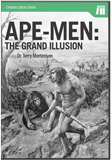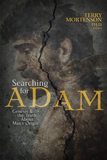
Making Monkeys out of Men
Editor’s Note: First published in St. Louis MetroVoice 5, no. 3 (March 1995).
The evolutionist’s notion that man evolved by chance from ape-like creatures is largely based upon certain anatomical similarities between apes and men. Being convinced that such similarities “prove” an evolutionary relationship, paleoanthropologists have declared certain fossil apes to be particularly “manlike” and, thus, ancestral to man. Similarly, in an effort to fill the gap between apes and men, certain fossil men have been declared to be “apelike” and, thus, ancestral to at least “modern” man. You might say this latter effort seeks to make a “monkey” out of man.
Humans are rarely found in the fossil record. This may be partly explained by the sort of habitat in which man typically lived, and by the extraordinary conditions required for fossilization (sudden burial in water-borne sediment which hardens before decomposition of the bones). The best-known human fossils are of Cro-Magnon man (whose marvelous paintings are found on the walls of caves in France) and Neanderthal man. Both are true men and are accordingly classified today as Homo sapiens.
Neanderthal man was first discovered in 1856 by workmen digging in a limestone cave in the Neander Valley near Dusseldorf, Germany. This specimen consisted of a fossilized skull cap, two femurs, two humeri and other bone fragments. The fossil bones were examined by an anatomist (professor Schaafhausen) who concluded they were human. At first, not much attention was given to these finds but, with the publication of Darwin’s On the Origin of Species in 1859, the search began for the imagined “apelike ancestors” of man. William King, an Irish geologist, reexamined the fossil skull of Neanderthal man and promptly declared that the “thoughts and desires which once dwelt within it never soared beyond those of the brute.” Clearly, anatomists are no match for geologists when it comes to discerning fossilized thoughts! Darwinians argued that Neanderthal man was an apelike creature, while many critical of Darwin (like the great anatomist Rudolph Virchow) argued that Neanderthals were human in every respect, though some appeared to be suffering from rickets or arthritis.
Over 300 Neanderthal specimens have now been found scattered throughout most of the world, including Belgium, China, Central and North Africa, Iraq, Czechoslovakia, Hungary, Greece, northwestern Europe and the Middle East. This group of men was characterized by prominent eyebrow ridges (like modern Australian aborigines), low forehead, long narrow skull, a protruding upper jaw, and a strong lower jaw with a short chin. They were deep-chested, large-boned individuals with a powerful build. It should be emphasized, however, that none of these features fall outside the range of normal human anatomy. Interestingly, the brain size (based on cranial capacity) of Neanderthal man was actually larger than average for that of modern man, though this is rarely emphasized. Anthropologists have long attempted to correlate brain size with intelligence and some have even biased their measurements of cranial capacity in an apparent effort to down-grade the intelligence of “less favored” groups, such as blacks and Indians (see The Mismeasure of Man by evolutionist Stephen Jay Gould, W. W. Norton & Company, 1981). There is, in fact, a broad range of variation in brain size among normal humans, but there is no known relationship between mere brain size and intelligence.
The overwhelming evidence [is] that Neanderthals were simply a group of stocky humans.
Despite the overwhelming evidence that Neanderthals were simply a group of stocky humans, imaginative artists (with the encouragement of some evolutionists) have consistently rendered them as stooped “ape-men.” For years, visitors entering Chicago’s Field Museum of Natural History were obliged to pass between a frightening pair of life-sized statues of a very bestial appearing Neanderthal couple. Today, the Museum has finally replaced these erroneous statues with a more accurate representation of erect standing human-like Neanderthals. The old ones, however, were moved to the second floor near the dinosaur skeletons, where they will continue to fuel the imaginations of generations of school children, who will believe they have actually seen “ape-men”!
Most of the misconceptions about Neanderthal man resulted from the claims of a Frenchman (Marcelin Boule) who, in 1908, studied two Neanderthal skeletons that were found in France (LeMoustier and La Chapelle-aux-Saints). Boule declared Neanderthal men to be anatomically and intellectually inferior brutes who were more closely related to apes than humans. He asserted they had a slumped posture, a “monkey-like” arrangement of certain spinal vertebrae, and even claimed that their feet were of a “grasping type” (like those of gorillas and chimpanzees). Boule concluded that Neanderthal man could not have walked erectly, but rather must have walked in a clumsy fashion. These highly biased and inaccurate views prevailed and were even expanded by many other evolutionists up to the mid-1950s.
In 1957, the anatomists William Straus and A. J. Cave examined one of the French Neanderthals (La Chapelle-aux-Saints) and determined that the individual suffered from severe arthritis (as suggested by Virchow nearly 100 years earlier), which affected the vertebrae and bent the posture. The jaw also had been affected. These observations are consistent with the Ice Age climate in which Neanderthals had lived. They may well have sought shelter in caves and this, together with poor diet and lack of sunlight, could easily have lead to diseases that affect the bones, such as rickets. In any event, the big toe was definitely not prehensile (grasping) as Boule had claimed, and the pelvis was not found to be apelike. In their report they commented that:
If he (Neanderthal man) could be reincarnated and placed in a New York subway—provided he were bathed, shaved and dressed in modern clothing—it is doubtful whether he would attract any more attention that some of its other denizens. (Quarterly Review of Biology 32:348–63).
In fact, today one could dispense with the bath and the shave!
Perhaps our best impression of what Neanderthal man actually looked like comes from the work of the forensic artist, Jay Matterens. Matterens, who specializes in “fleshing out” skeletons with modeling clay to aid in the identification of homicide victims, worked closely with anthropologists to “flesh out” a skeleton of Neanderthal man. The result, pictured prominently on the cover of the magazine Science 81 (October, 1981), was essentially indistinguishable from modern man! Matterens admitted that he had to fight against his preconceptions to reconstruct what the measurements showed. The accompanying article in the magazine pointed out that “in the view of many paleoanthropologists, the story of human evolution has been fictionalized to suit needs other than scientific rigor.”
There is a growing body of cultural evidence for the fully human status of Neanderthals.
In addition to anatomical evidence, there is a growing body of cultural evidence for the fully human status of Neanderthals. He buried his dead and had elaborate funeral customs that included arranging the body and covering it with flowers. He made a variety of stone tools and worked with skins and leather. There is even evidence which suggests that he engaged in medical care. Some Neanderthal specimens show evidence of survival to old age despite numerous wounds, broken bones, blindness and disease. This suggests that these individuals were cared for and nurtured by others who showed human compassion.
Still, efforts continue to be made to somehow dehumanize Neanderthal man. Some investigators have insisted that Neanderthal man was anatomically incapable of speech but recent studies show that he had a laryngeal anatomy entirely consistent with speech. One of the world’s foremost authorities on Neanderthal man, Erik Trinkaus, concludes:
Detailed comparisons of Neanderthal skeletal remains with those of modern humans have shown that there is nothing in Neanderthal anatomy that conclusively indicates locomotor, manipulative, intellectual or linguistic abilities inferior to those of modern humans. (Natural History 87:10).
Why then are there continued efforts to make apes out of man and man out of apes?
In one of the most remarkably frank and candid assessments of the whole subject and methodology of paleoanthropology, Dr. David Pilbeam (professor of anthropology at Yale) suggested that
perhaps generations of students of human evolution, including myself, have been flailing about in the dark; that our data base is too sparse, too slippery, for it to be able to mold our theories. Rather the theories are more statements about us and ideology than about the past. Paleoanthropology reveals more about how humans view themselves than it does about how humans came about. But that is heresy. (American Scientist 66:379)
Oh, that these heretical words were printed as a warning on every textbook, magazine, newspaper article, and statue that presumes to deal with the bestial origin of man!
Essays on Origins: Creation vs. Evolution
Recommended Resources

Answers in Genesis is an apologetics ministry, dedicated to helping Christians defend their faith and proclaim the good news of Jesus Christ.
- Customer Service 800.778.3390
- © 2024 Answers in Genesis




